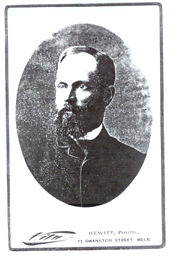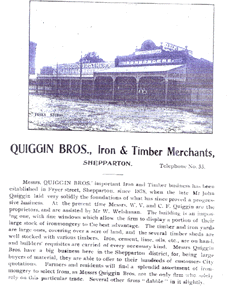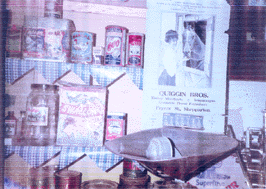|
John Quiggin was born February 8, 1820 in Ramsay, Isle of Man, United
Kingdom. He was christened there the following day, February 9, 1820. In
his 19th year John left The Isle of Man for Liverpool, where he remained for
a short time, taking his departure for Canada, where he carried on business
as a building contractor at Kingston, on Lake Ontario.
While in Canada, he married Hannah Vincent at St George Cathedral,
Kingston, Ottawa on January 21, 1850.
Their family
John and Hannah had five sons and three daughters |
 |
George Alfred Quiggin was born in 1850. No record of any marriage
has been found. George died of Tuberculosis on 5 January 1895 at the Lunatic
Asylum, Yarra Bend, Victoria, Australia.
William Vincent Quiggin was born on 27 April 1851. He married
Alice Tatham in 1910 and they had one daughter, Bernice Florence Quiggin in
1911. He is currently recorded as dying in 1905 however this is impossible
given the above dates.
John Edwin Quiggin was born March 21, 1853 and married
Caroline Ellen Robertson on 9 March 1881. They later divorced after having 5
children Edwin Vincent James A Quiggin, Albert Stanley Quiggin, John Charles
Fairfield Quiggin, William Vincent Quiggin and Marguerite Iris Quiggin. On 25
August 1897 John married May Winifred Rutherford and they had 5 sons Sidney
Rupert Quiggin, Arthur Vincent Mackay Quiggin, Wilfred Charles L Quiggin,
Clarence Edwin Quiggin and Laurence Rutherfurd Quiggin. John died on
November 12, 1932.
Charles Frederick Quiggin was born about 1855. He never married.
Charles was reputed to be the "black sheep" of the family, squired quite a few
births and did the family out of a lot of money. He died of syphilis on 15
August 1885.
Hannah Rosamund Quiggin was born in 1857 and died in 1863.
Albert Edward Quiggin was born in 1860. He only lived for 14 years,
dying on 7 September 1874.
Edith Gertrude Quiggin was born in 1863 and married McGinn Sharp. Edith
worked as a servant.
Annie Quiggin was born on 12 April 1865. She died in 1874, aged 8
years.
Some years later John Quiggin removed further west to London and Hamilton,
near Niagara Falls where he entered the milling business, following the flow of
population westward, he entered the United States of America and erected
sawmills at Milwaukie and Chicago, on Lake Michegan.
In the year 1858 John, his wife Hannah, and their first five children
(George, William, John, Charles and Hannah) moved south to St Louis, a large
city on the Missisippi, where he entered into the timber business on a very
extensive scale, and with much success until the Civil War broke out in 1860.
Soon after this he met with a great loss, having his sawmill and entire stock
of building material destroyed by fire, but not being discouraged, he took a
partner, and they soon had new mills erected and the business was again in full
swing.
But the fearful war still continued, and the fighting was so close at hand
that, after having had two narrow escapes from losing his life, he sold his
interest in the business to his partner at a great sacrifice. John refused to be
naturalised and moved with his family back to Canada for safety.
Leaving his family at Port Hope, he started out to look for fresh fields.
After a tour through Canada, Nova Scotia and New Brunswick, he went to New York
and from thence took steamer for San Francisco, crossing the Isthmus of Panama,
after a stay of only a month at this city. He afterwards left for Vancouver
Island, where he took the management of a large Oregon sawmilling business.
Not thinking the place suitable to rear a young family in (there were only
two white women on the island at that time) he decided to try his fortune in
Australia, and left Vancouver in 1873 in a sailing vessel with a cargo of timber
for Sydney via Cape Horn. Their first port of call was Boston. After sailing
from Boston, their ship, "Thos W. House" was involved in a collision and had to
return to Boston in a badly damaged condition. She was 3 months refitting.
Sailing again, the ship was some time out of Boston when she was chased by a
southern privateer, but escaped in the darkness. "Thos W. House" docked in
Australia on 26 December 1863.
After visiting Tasmania John finally settled in Melbourne, Victoria and
started in business as a shipping and commission agent, and very soon got a
large connection, principally with Tasmania. Success accompanied his efforts,
and eventually he became the owner of a number of sailing vessels and agent for
many more. But the extraordinary rapid progress made in improvements in
steamships soon enabled them to compete successfully with the sailing vessels.
John, foreseeing what was coming, disposed of his shipping interest, but still
continued to carry on the timber and commission business at his office in
Flinders Street, Melbourne.
The Quiggins also had quite a large land-holding and homestead in Wynyard,
Tasmania, as John's younger brother, Robert, had immigrated there in 1853.
In 1876 John visited the Goulburn Valley and thoroughly explored the red gum
forests along the river from McCoy's Bridge up to Nagambie. He was so impressed
with their extent and value that he at once decided to erect a number of
sawmills. The first and most extensive he built in Mooroopna, at a cost of about
1000 pounds. He hurried the erection of this mill, anticipating that the
Goulburn Valley railway was to be constructed at once, but the general election
of 1877 and consequent change in the Government altered matters. The Berry
Ministry changed the route from the west to the east side of the river, thus
necessitating a new survey and a delay of a full 2 years. This was a serious
loss.
| In 1878 he erected
sawmills at Toolamba and Murchison, and later on at Kialla, Arcadia, Cooma
and Coomboona, besides a second one at Murchison. With these mills he cut
nearly the whole of the timber required in the construction of the railway
from Nagambie to Shepparton, besides that for many other lines throughout
the colony. In addition to this, for seven years he was a successful
tenderer to the Victorian Railway Commissioners.
In 1878 John started a branch of
his timber business in Wyndham Street, Shepparton, Victoria on an allotment
of land on which the public buildings now stand, and which he leased from
the late Mr George North. In 1880 Mr Welchman took the management of this
branch, which he conducted successfully ever since. |
 |
| About 1880 the
Shepparton and Melbourne businesses were transferred to John's sons, who
carried them on under the style of Quiggin Bros. [The brothers lost the
Shepparton business during the bank foreclosures around 1920].
In 1880 John Quiggin removed all his
sawmills to Gippsland, where he carried on an extensive business up to the
time of his death, following a paralytic stroke on Tuesday 21st November
1893. John died on Saturday 25 Novemver 1893 at Power Street, Hawthorn,
Victoria |
 |
Tribute (Believed to have been written by a close friend of John Quiggin)
John never engaged in public life. Indeed, he appeared to have quite an
aversion to politics. In business he was honest, energetic and persevering, and
in social life was all that could be desired - a good husband, a kind father,
and a firm friend. He was generous and benevolent in the highest sense, and the
hungry or distressed never left his door unsatisfied. He was a firm believer in
the Christian religion, and especially so during the later period of his life.
He evinced much earnestness in making his "calling and elected sure". Well
educated, and with a mind stored with a varied fund of knowledge, he was a
companion of the most interesting kind, and his loss was keenly felt by all who
had the pleasure of his acquaintance.


